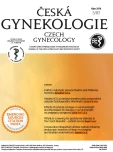Úskalí screeningu gestačního diabetu v České republice – průzkum mezi pacienty
Authors:
P. Šimják 1; K. Anderlová 1,2; H. Krejčí 1,2; V. Krejčí 1; P. Pařízková 3; M. Mráz 4,5; M. Kršek 6; M. Haluzík 4,5,7,8; A. Pařízek 1
Published in:
Ceska Gynekol 2018; 83(5): 348-353
Category:
Overview
Cíl:
Cílem naší studie bylo prozkoumat, jak probíhá screening gestačního diabetu v České republice s ohledem na správnost metodických postupů screeningu.
Metodika:
Celkem 1100 anonymních dotazníků bylo rozdáno těhotným ženám v prenatální poradně Gynekologicko-porodnické kliniky 1. LF UK a VFN v Praze v období od července do září 2015.
Výsledky:
958 (87,0 %) dotazníků bylo možno analyzovat; 794 (82,9 %) dotazovaných mělo alespoň jeden rizikový faktor pro vznik GDM. OGTT byl proveden u 751 (94,6 %) žen, s rizikovými faktory pro GDM a 153 (93,3 %) žen s nízkým rizikem rozvoje GDM. Z 904 provedených oGTT bylo 154 (17,0 %) provedeno zcela podle doporučených postupů. Ve zbývajících případech byla zaznamenána alespoň jedna metodická chyba. Výsledky oGTT poskytlo 364 (40,3 %) respondentů. V této skupině mělo 71 (19,5 %) žen pozitivní screening GDM podle kritérii Mezinárodní asociace pro studium diabetu v těhotenství (IADPSG). Většinou to však nebyly ty ženy, které byly gynekologem označeny jako screening pozitivní.
Závěr:
Screening GDM nebyl často proveden v souladu s doporučeným postupem a použitá diagnostická kritéria nebyla jednotná.
Klíčová slova:
gestační diabetes mellitus, screening, orální glukózový toleranční test, glykémie nalačno, průzkum
Sources
1. American Diabetes Association. Classification and Diagnosis of Diabetes. Diabetes Care, 2017, 40, suppl. úůp1, p. 11–24.
2. Andelova, K., Anderlova, K., Cechurova, D., et al. Gestational diabetes mellitus – guideline. 2015. Retrieved from http://www.prolekare.cz/en/czech-gynaecology-article/gestacni-diabetes-mellitus-doporuceny-postup-57027.
3. Boney, CM., Verma, A., Tucker, R., Vohr, BR. Metabolic syndrome in childhood: association with birth weight, maternal obesity, and gestational diabetes mellitus. Pediatrics, 2005, 115(3), p. 290–296.
4. Clausen, TD., Mathiesen, ER., Hansen, T., et al. Overweight and the metabolic syndrome in adult offspring of women with diet-treated gestational diabetes mellitus or type 1 diabetes. J Clin Endocrinol Metab, 2009, 94, p. 2464–2470.
5. Colagiuri, S., Sandbaek, A., Carstenten, B., et al. Comparability of venous and capillary glucose measurements in blood. Diabet Med, 2003, 20, p. 953–956.
6. Crowther, CA., Hiller, JE., Moss, JR., et al. Effect of treatment of gestational diabetes mellitus on pregnancy outcomes. N Eng J Med, 2005, 352, p. 2477–2486.
7. Daly, N., Flynn, I., Carrol, C., et al. Impact of implementing preanalytical laboratory standards on the diagnosis of gestational diabetes mellitus: a prospective observational study. Clin Chem, 2016, 62, p. 387–391.
8. Daly, N., Stapleton, M., O’Kelly, R., et al. The role of preanalytical glycolysis in the diagnosis of gestational diabetes mellitus in obese women. Am J Obstet Gynecol, 2015, 213(1), p. 84.e1–84.e5.
9. Desai, M., Beall, M., Ross, MG. Developmental origins of obesity: programmed adipogenesis. Curr Diab Rep, 2013, 13, p. 27–33.
10. Griffin, ME., Coffey, M., Johnson, H., et al. Universal versus risk factor based screening for gestational diabetes mellitus detection rates, gestation at diagnosis and outcome. Diabet Med, 2000, 17, p. 26–32.
11. Guo, J., Chen, JL., Whittemore, R., Whitaker, E. Postpartum lifestyle interventions to prevent type 2 diabetes among women with history of gestational diabetes: a systematic review of randomized clinical trials. J Womens Health, 2016, 25, p. 38–49.
12. Hartling, L., Dryden, DM., Guthrie, A., et al. Benefits and harms of treating gestational diabetes mellitus: a systematic review and meta-analysis for the U.S. Preventive Services Task Force and the National Institutes of Health Office of Medical Applications of Research. Ann Intern Med, 2013, 159, p. 123–129.
13. Kim, C., Newton, KM., Knopp, RH. Gestational diabetes and the incidence of type 2 diabetes. Diabetes Care, 2002, 10, p. 1862–1868.
14. Knudsen, S., Karstoft, K., Pedersen, BK., et al. The immediate effects of a single bout of aerobic exercise on oral glucose tolerance across the glucose tolerance continuum. Physiological Reports, 2014, 2(8), p. e12114.
15. Metzger, BE., Gabbe, SG., Persson, B., et al. International association of diabetes and pregnancy study groups recommendations on the diagnosis and classification of hyperglycemia in pregnancy. Diabetes Care, 2010, 33, p. 676–682.
16. Mills, JL. Malformations in infants of diabetic mothers. Birth defects research. Part A. Clin Molecular Teratol, 2010, 88(10), p. 769–778.
17. Mooy, JM., Grootenhuis, PA., deVries, H., et al. Intra-individual variation of glucose, specific insulin and pro–insulin concentrations measured by two oral glucose tolerance tests in a general Caucasian population; The HOORN Study. Diabetologia, 1996, 39, p. 298–305.
18. Nahum Sacks, K., Friger, M., Shoham-Vardi, I., et al. Prenatal exposure to gestational diabetes mellitus as an independent risk factor for long-term neuropsychiatric morbidity of the offspring. Am J Obstet Gynecol, 2016, 215(3), p. 380.e1–380.e7.
19. Petrovic, O., Belci, D. A critical appraisal and potentially new conceptual approach to screening and diagnosis of gestational diabetes. J Obstet Gynaecol, 2017, 37(6), p. 691–699.
20. Sacks, DB., Arnold, M., Bakris, GL., et al. Guidelines and recommendations for laboratory analysis in the diagnosis and management of diabetes mellitus. Clin Chem, 2011, 57, p. e1–e47.
21. Shirazian, N., Mahboubi, M., Emdadi, R., et al. Comparison of different diagnostic criteria for gestational diabetes mellitus based on the 75-g oral glucose tolerance test: a cohort study. Endocrine Practice, 2008, 14(3), p. 312–317.
22. World Health Organization. Definition, diagnosis and classification of diabetes mellitus and its complications: report of a WHO consultation, part 1: Diagnosis and classification of diabetes mellitus. 1999. 2nd ed.
23. Wu, CS., Nohr, EA., Bech, BH., et al. Long-term health outcomes in children born to mothers with diabetes: a population-based cohort study. PLoS One, 2012, 7, p. e36727.
Labels
Paediatric gynaecology Gynaecology and obstetrics Reproduction medicineArticle was published in
Czech Gynaecology

2018 Issue 5
Most read in this issue
- Hladina hCG po embryotransferu jako prognostický ukazatel fyziologického těhotenství
- Vaginální mikrobiom
- Pánevní aktinomykóza a IUD
- Poruchy příjmu potravy v těhotenství
